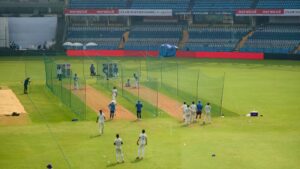
Atreyo Mukhopadhyay in Mumbai
Pedology. It’s a word not remotely connected with cricket. Yet, it resonates every now and then, when Test cricket visits the Indian shores. It gets intricately related with the game, especially when it comes to the prelude to a game and refuses to leave, until the national team moves to other countries. It’s a so close yet so distant relative of India’s cricketing fortunes.
Pedology means the science of soils. It studies the chemistry of the contents of its composition and decodes the unknown facts, like the chemical components, formation and evolution. In cricketing terms, it tries to explain how a pitch may behave, based on its natural and artificial constituents and external factors like heat, humidity and moisture.
Of late, one can notice an overdose of this. Take the ongoing New Zealand series for example. There is excessive talk on the pitch and the ratio of colours of different types of soil in it. Is it red? Is it black? How much is the proportion, if it’s a mix of both. It seems that the time is not far when people start talking about the amount of blue and pink soil when it comes to cricket pitches.
While the nature of the pitch does sometimes play a role in determining the outcome of cricket matches and it’s natural that people talk about it, there is no need to overdo it. A pitch is something on which two teams bat and bowl, with varying degrees of familiarity. Both teams have difficulties and comforts on it. In that sense, it’s futile to lose sleep over it.
That is something which has gone missing in India. Before every Test match, talk invariably revolves around the nature of the surface and its chemical composition. X percentage of this soil, Y percentage of the other variety, the amount of mix and the possible impact of the weather on the entire thing. Good god! This is not agriculture. It’s not supposed to yield crop.
For the Latest Sports News: Click Here

“The red-soil wicket at Wankhede will bring pace, bounce and turn. It’s just a matter of when,” said Abhishek Nayar ahead of the third Test in Mumbai. There is no reason to mock at India’s assistant coach. He merely reiterated what has been said for years. But if one begs his pardon and asks what does it mean? What will be the answer?
Pace, bounce and turn — if all are seen at the same time — will make it impossible for batters to have a good time. That way, it will be an unplayable pitch. Having said that, Nayar added a crucial corollary. “It’s just a matter of when.” That was the key word. He predicted all these things without being able to specify to what extent it will impact this Test and when.
That is precisely the problem with this pitch obsession and predictions. A lot of people say a lot of things without being able to explain how exactly they will affect a Test match. The media goes gaga over it and keeps playing things on the loop. Nobody can pinpoint the exact correlation of the nature of the soil and the possible outcome of a game. They raise more questions than they answer.
That’s why this obsession better comes to an end. It does nobody any good. It is more counterproductive than intuitive. It causes more confusion than facilitating clarification. It becomes unfortunate, when even seasoned Test teams get carried away by these talks and try to influence opinion. In many cases, it leads to something detrimental.
Did New Zealand lose sleep over the nature of soil during their maiden Test series win in India? Did anyone hear South Africa say anything about the pitch in the ongoing series in Bangladesh they are dominating? Teams that think less about this and concentrate on the nature of cricket usually do better. For India to win the last Test, they must get rid of this obsessive and compulsive disorder.
Also Read: Marked stumps and short stuff: Team India gear up to tackle Mumbai’s red-soil pitch




